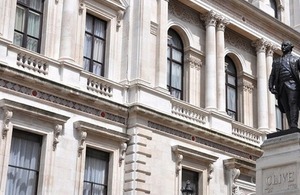Map Reveals Worldwide Impacts of Climate Change
The Foreign and Commonwealth Office launched a new map that reveals worldwide impact of climate change on 16 July in the United Kingdom

A new map, launched by the British Government on 16 July 2014, shows the impact climate change could have on the whole planet by the end of the century, if carbon emissions continue to increase.
The Human Dynamics of Climate Change map, developed by the Hadley Centre of the UK’s Meteorological Office, shows a range of potential impacts:
- Temperatures on the warmest days of the year rising by 6°C or more across Europe, parts of Asia and part of North America
- An increase in risk of flooding across 70% of Asia
- The number of days of drought going up by more than 20% in parts of South America, Australia and Southern Africa
- Maize yields falling by up to 12% in Central America
- Sea temperatures rising by up to 4°C in some parts of the world
- Millions of people flooded due to sea level rise, particularly in East, Southeast and South Asia
The map illustrates how climate change could affect the global economy as regions connected by trade are affected by changes in crop yield, droughts, flooding and high temperatures. It also shows how many already water-stressed regions of the world could face an increase in the frequency and duration of droughts, at the same time as an increase in demand for water for agriculture and for the consumption of a growing population.
Commenting on the impact of climate change on Zambia, British High Commissioner James Thornton said:
“The changing rain patterns and the flooding Zambia has experienced in the past rain seasons are an example of the sort of climate variability that will become more common as global temperatures rise. The new map reinforces the point that Zambia is not immune. The UK government is determined to show leadership on reducing these risks. We are already supporting Zambia’s Climate Resilience and other climate change awareness programmes. And Zambia can play a valuable role in working at the UN’s climate change meetings for a global agreement on tackling the problem.”
Foreign Office Minister, Mark Simmonds said:
“This map shows how the impacts of climate change on one part of the world will affect countries in other parts of the world, particularly through the global trade in food. This reinforces the point that climate change is a global problem: no country is immune, and we all need to work together to reduce the risks to our shared prosperity and security.”
Dame Julia Slingo, the Meteorological Office Chief Scientist, said:
“We’ve used the latest science to assess how potential changes in our climate will impact people around the world. This map presents that information together for the first time. While we see both positive and negative impacts, the risks vastly outweigh any potential opportunities”.
The launch event included a discussion on climate change led by Sir David King, the Foreign Secretary’s Special Representative on Climate Change and Sir Mark Walport, the Government’s Chief Scientific Adviser. The map can be viewed at www.metoffice.gov.uk/human-dynamics.
Further information
-
The Meteorological Office developed this product using data from the Inter-Sectoral Impact Model Comparison Project (ISI-MIP) with specific contributions from Centre for Ecology and Hydrology, Wallingford, Utrecht University, University of Southampton, Global Climate Forum, the Agricultural Model Intercomparison and Improvement Project, the Center for Robust Decision Making in Climate and Energy Policy and the Met Office Hadley Centre.
-
The British Government considers climate change to present a great risk to our future global prosperity and security. So as well as reducing emissions domestically, the UK is also working closely with a wide range of countries to achieve effective global action to limit climate change to 2°C. The Foreign and Commonwealth Office uses its worldwide network of Embassies and High Commissions to support this effort.
-
All the latest news is available on the Foreign Office page of the gov.uk website at: www.gov.uk/fco
Follow the Foreign Office on twitter @foreignoffice Follow the Foreign Office on facebook and Google+ Follow the British High Commission on facebook and twitter @UkinZambia.
-
The Meteorological Office is the UK’s National Meteorological Service (NMS) responsible for providing the UK’s public weather service and a trading fund of the Department for Business, Innovation and Skills. The Hadley Centre is a global centre of expertise on climate change.
-
The UK Government, though the Meteorological Office, in 2012 donated a digital video file recorder valued at British Pounds 1,500 to the Zambia Meteorological Department to improve weather and climate forecast, and support sustainable development.
-
Zambia is one of three African pilots for the significant Pilot Programme for Climate Resilience (run by World Bank). The UK is also the largest single donor to the Pilot Project for Climate Resilience which saw Zambia access $1.5 million in phase 1 and $50million in grants in phase 2 in order to scale up Zambia’s climate change adaptation response.
-
For further information contact the Press and Public Affairs Section on +260 211 423200 or Alfred Kapalayi on +260 955 945771
British High Commission, Lusaka 18 July 2014